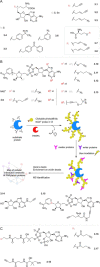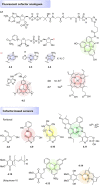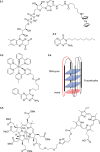Functionalised Cofactor Mimics for Interactome Discovery and Beyond
- PMID: 35286003
- PMCID: PMC9401033
- DOI: 10.1002/anie.202201136
Functionalised Cofactor Mimics for Interactome Discovery and Beyond
Abstract
Cofactors are required for almost half of all enzyme reactions, but their functions and binding partners are not fully understood even after decades of research. Functionalised cofactor mimics that bind in place of the unmodified cofactor can provide answers, as well as expand the scope of cofactor activity. Through chemical proteomics approaches such as activity-based protein profiling, the interactome and localisation of the native cofactor in its physiological environment can be deciphered and previously uncharacterised proteins annotated. Furthermore, cofactors that supply functional groups to substrate biomolecules can be hijacked by mimics to site-specifically label targets and unravel the complex biology of post-translational protein modification. The diverse activity of cofactors has inspired the design of mimics for use as inhibitors, antibiotic therapeutics, and chemo- and biosensors, and cofactor conjugates have enabled the generation of novel enzymes and artificial DNAzymes.
Keywords: Chemical Probes; Cofactors; Photoaffinity Labelling; Protein Modifications; Proteomics.
© 2022 The Authors. Angewandte Chemie International Edition published by Wiley-VCH GmbH.
Conflict of interest statement
The authors declare no conflict of interest.
Figures





Similar articles
-
Profiling the Heme-Binding Proteomes of Bacteria Using Chemical Proteomics.Angew Chem Int Ed Engl. 2023 Feb 20;62(9):e202212111. doi: 10.1002/anie.202212111. Epub 2023 Jan 23. Angew Chem Int Ed Engl. 2023. PMID: 36495310
-
Functional diversity of organic molecule enzyme cofactors.Nat Prod Rep. 2013 Oct 11;30(10):1324-45. doi: 10.1039/c3np70045c. Epub 2013 Aug 12. Nat Prod Rep. 2013. PMID: 23934236 Review.
-
Discovery of Electrophiles and Profiling of Enzyme Cofactors.Curr Protoc Chem Biol. 2020 Dec;12(4):e86. doi: 10.1002/cpch.86. Curr Protoc Chem Biol. 2020. PMID: 33197155 Free PMC article.
-
DNA-assisted site-selective protein modification.Biopolymers. 2022 Mar;113(3):e23483. doi: 10.1002/bip.23483. Epub 2021 Dec 8. Biopolymers. 2022. PMID: 34878181 Free PMC article. Review.
-
New transition-metal-dependent DNAzymes as efficient endonucleases and as selective metal biosensors.Chemistry. 2002 Oct 18;8(20):4589-96. Chemistry. 2002. PMID: 12561102
Cited by
-
A Chemical Proteomic Map of Heme-Protein Interactions.J Am Chem Soc. 2022 Aug 24;144(33):15013-15019. doi: 10.1021/jacs.2c06104. Epub 2022 Aug 12. J Am Chem Soc. 2022. PMID: 35960875 Free PMC article.
-
Modulators of a robust and efficient metabolism: Perspective and insights from the Rid superfamily of proteins.Adv Microb Physiol. 2023;83:117-179. doi: 10.1016/bs.ampbs.2023.04.001. Epub 2023 Apr 29. Adv Microb Physiol. 2023. PMID: 37507158 Free PMC article. Review.
-
A Chemical Proteomic Strategy Reveals Inhibitors of Lipoate Salvage in Bacteria and Parasites.Angew Chem Int Ed Engl. 2023 Aug 1;62(31):e202304533. doi: 10.1002/anie.202304533. Epub 2023 Jun 26. Angew Chem Int Ed Engl. 2023. PMID: 37249408 Free PMC article.
-
Exploring antibiotic resistance with chemical tools.Chem Commun (Camb). 2023 May 18;59(41):6148-6158. doi: 10.1039/d3cc00759f. Chem Commun (Camb). 2023. PMID: 37039397 Free PMC article. Review.
-
Patent landscape of small molecule inhibitors of METTL3 (2020-present).Expert Opin Ther Pat. 2024 Dec 26:1-16. doi: 10.1080/13543776.2024.2447056. Online ahead of print. Expert Opin Ther Pat. 2024. PMID: 39721070 Review.
References
-
- Fischer J. D., Holliday G. L., Rahman S. A., Thornton J. M., J. Mol. Biol. 2010, 403, 803–824. - PubMed
-
- Richter M., Nat. Prod. Rep. 2013, 30, 1324–1345. - PubMed
-
- Katz E., Schlereth D. D., Schmidt H. L., Olsthoorn A. J. J., J. Electroanal. Chem. 1994, 368, 165–171.
-
- Xiao Y., Patolsky F., Katz E., Hainfeld J. F., Willner I., Science 2003, 299, 1877–1881. - PubMed
Publication types
MeSH terms
Substances
Grants and funding
LinkOut - more resources
Full Text Sources

